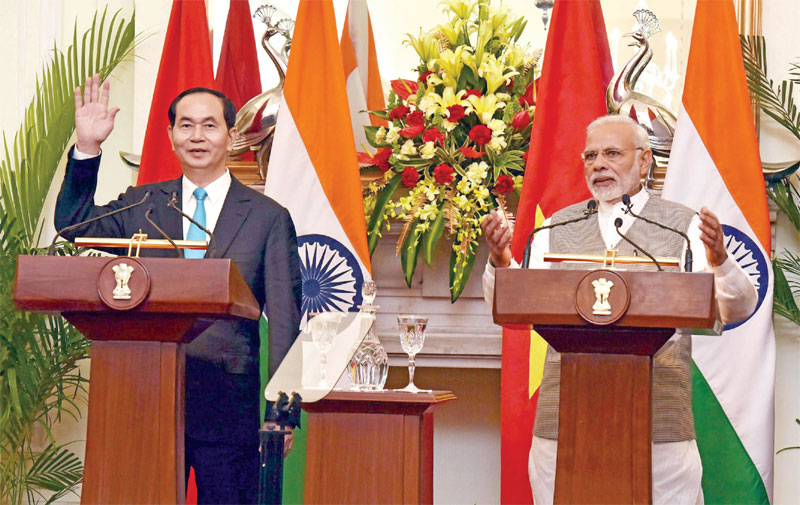Vietnam’s location and intent to pursue a pragmatic foreign policy are critical to India’s interest in the region
Smruti D
The South China Sea (SCS), which stretches 3.6 million square kilometres, is regarded as one of the most strategically prominent regions in the world. China’s dominance in the region has made it a centre of global attention. Apart from countries like Vietnam, the Philippines, Brunei, Malaysia and Taiwan who have direct stakes in the region, the other major global and extra-regional powers like US, Australia, Japan and India are also following China’s ministrations in SCS seriously.

What makes the SCS region hotly disputed is its economic value. SCS serves as an important transit route with almost USD5.3 trillion worth of total world trade passing through these waters annually. At the heart of the dispute are also the huge reserves of oil and natural gas in the region. The US estimates these to be 11 billion barrels of oil and 190 trillion cubic feet of natural gas. Peace in SCS is the need of the hour as any major conflict in the region would paralyse security regionally as well as globally. The shipping lane passing from between the Spratly and Paracel islands is used to transport oil to Japan, China and South Korea from the Middle East. Both Japan and China have at least 80-90 per cent of oil flowing through the SCS. It is also a transit route for warships traversing the Indian and Pacific oceans.
Even when India has no direct role to play in the SCS, the present dispute in the SCS is of great concern to it because more than 50 per cent of India’s maritime trade in the Asia-Pacific passes through this channel. Of utmost importance to India is that its economic prosperity is dependent on maritime trade. Safeguarding the sea lanes that enable trade have to be preserved from volatility. India has repeatedly pushed for the resolution of disputes in accordance with the United Nation Convention of the Law of the Sea (UNCLOS) in the SCS.
As India has engaged with the ASEAN to safeguard the Indian Ocean from China’s unwelcome forays, any difficulty that ASEAN faces in dealing with China would have a direct impact on India’s security. SCS is also of importance to India because of the natural reserves it contains. With growing energy demands, the natural resources found in the SCS too become important for India. Research Scholar from Centre for Indo-Pacific Studies JNU, Niranjan C Oak says, “India has strategic interests to protect in the South China Sea. ONGC Videsh Ltd has oil blocks in the waters off the coast of Vietnam. The blocks are important in the view of India’s energy security. Moreover, sheer presence is a form of naval diplomacy and the access to the Vietnamese ports serves the purpose for Indian naval diplomacy.”
The US, too, is not a claimant in the SCS. Its involvement, by deploying patrol ships and aircraft is strategic. As China goes on to claim almost 90 per cent of the SCS, through its nine-dash line, the US pushes for freedom of navigation in the area, in order to safeguard the important transit routes for all of Indian and Pacific oceans. The role of the US and India, however, cannot be underestimated in the region because, being direct rivals of China, the two countries are fighting China’s unfair claims over resources that do not belong to China alone.
The South China Sea Dispute
Vietnam lies in the easternmost part of the Indochinese peninsula, sharing a border to the north with China which stretches 1297km. Both, India and Vietnam are fighting China’s expansionism. Even though Vietnam is a signatory to China's Belt and Road Initiative (BRI) and the two countries maintain diplomatic ties, the relationship is fraught with maritime disputes.
On whether the BRI project is of any benefit to Vietnam, Niranjan C Oak, says, “BRI is designed to benefit the middle kingdom. Benefits envisaged for the participating countries are of secondary nature. The primary aim of the BRI is to address the internal issue of overcapacity. Externally, the BRI is designed to take smaller countries under China’s wings through the debt trap diplomacy. Although Vietnam has endorsed the BRI, it is extremely careful and cautious with the projects that are approved for Hanoi. I see Vietnam’s acceptance of the BRI more as a hedging strategy employed by Hanoi vis-a-vis its external relations rather than endorsement of the BRI itself.”
You must be logged in to view this content.

